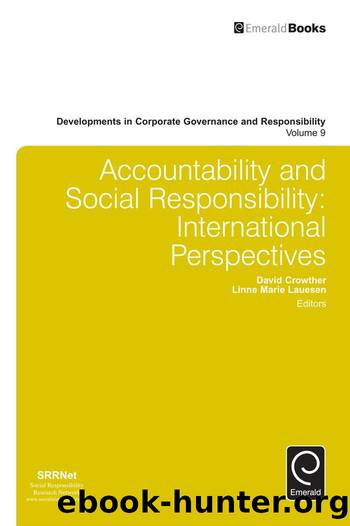Accountability and Social Responsibility by Crowther David;Lauesen Linne;

Author:Crowther, David;Lauesen, Linne;
Language: eng
Format: epub
Publisher: Emerald Publishing Limited
Published: 2016-07-12T00:00:00+00:00
The correlation of the returns of the LIFI Index to the returns of the MSCI EM Banks Index has been 66% on average since November 2003. The correlation between the two indices decreased meaningfully in the second half of 2011, reaching a low of 41%, and it came back to average levels of 89% in 2012. According to De Mariz et al. (2012), this was mostly due to the LIFI Index being relatively resilient to global turmoil (U.S. rating downgrade and European sovereign crisis) in August and September 2011.
Brière and Szafarz (2015) evaluate the profitability of investing in microfinance via stock markets. The authors build microfinance indices: one microfinance index per country and one global microfinance index. These indices differ from the LIFI Index developed by J. P. Morgan that includes MFIs and other financial institutions serving the same public. The authors choose to analyse only listed MFIs, thus the results of their study should be analysed with precaution. Brière and Szafarz (2015) found that investing in microfinance is very profitable, since as of 31 December 2010, the majority of listed MFIs have high returns (profitability), except a few MFIs like Blue Financial Services in South Africa. Volatilities of MFIs in emerging markets are very high, ranging from 39.41% to 106.87%, while the average volatility of these markets is of 28%. The authors found that starting in 2001, the correlation between financial markets and listed MFIs has increased. This suggests that MFIs, especially those listed on a stock market, are becoming more like commercial banks.
Nevertheless, according to De Mariz et al. (2013), listed MFIs have a discount of between 13% and 23% compared to traditional commercial banks depending on the multiple capitalisation retained. In 2010, price earnings ratios were estimated at 16.2 for commercial banks versus 12.4 times earnings for MFIs. Moreover, although the return on equity displayed is higher than traditional banks (22% vs. 19%), the market to book ratio was 2.6 times for MFIs against 3.0 times for traditional banks. Regarding risk, analysis based on the CAPM6 leads to a higher sensitivity of MFIs. In contrast, exposure to currency risk is similar for both types of assets. Brière and Szafarz (2015) conclude that there is a reduction of the effect of MFI diversification.
Download
This site does not store any files on its server. We only index and link to content provided by other sites. Please contact the content providers to delete copyright contents if any and email us, we'll remove relevant links or contents immediately.
Hit Refresh by Satya Nadella(8347)
The Compound Effect by Darren Hardy(7586)
Change Your Questions, Change Your Life by Marilee Adams(6667)
Nudge - Improving Decisions about Health, Wealth, and Happiness by Thaler Sunstein(6646)
The Black Swan by Nassim Nicholas Taleb(6209)
Daring Greatly by Brene Brown(5663)
Deep Work by Cal Newport(5513)
Principles: Life and Work by Ray Dalio(5340)
Rich Dad Poor Dad by Robert T. Kiyosaki(5173)
The Myth of the Strong Leader by Archie Brown(4796)
Man-made Catastrophes and Risk Information Concealment by Dmitry Chernov & Didier Sornette(4754)
Big Magic: Creative Living Beyond Fear by Elizabeth Gilbert(4740)
The Slight Edge by Jeff Olson(4732)
Discipline Equals Freedom by Jocko Willink(4649)
Digital Minimalism by Cal Newport;(4587)
The Motivation Myth by Jeff Haden(4542)
Stone's Rules by Roger Stone(4426)
Management Strategies for the Cloud Revolution: How Cloud Computing Is Transforming Business and Why You Can't Afford to Be Left Behind by Charles Babcock(4141)
The Doodle Revolution by Sunni Brown(4055)
